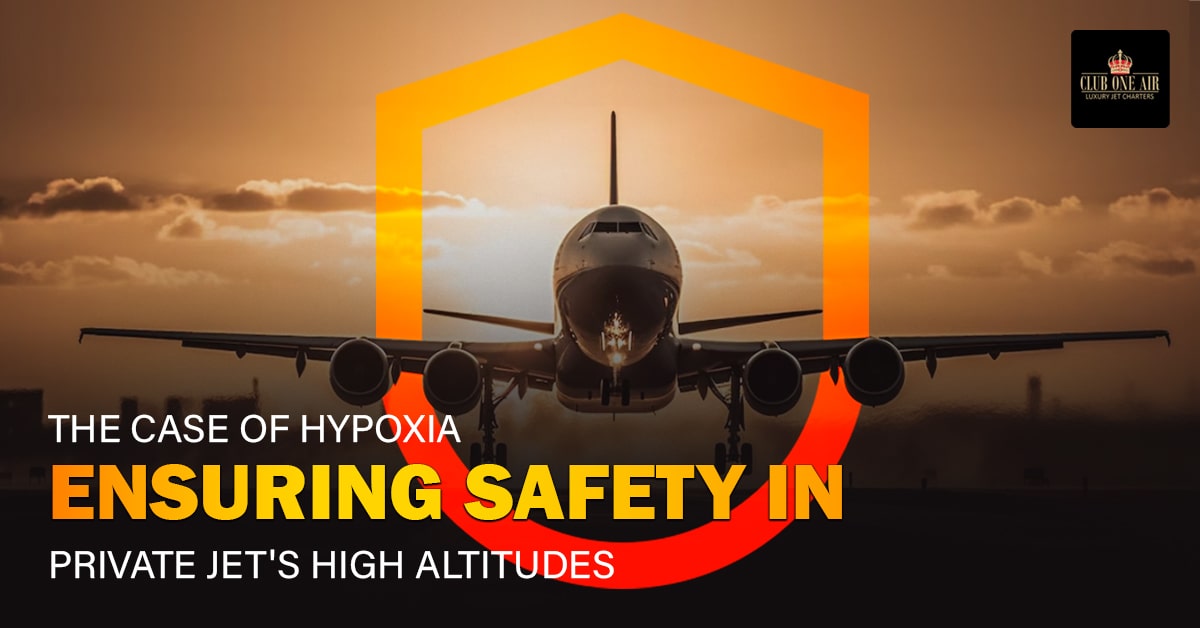The Case of Hypoxia- Ensuring Safety in Private Jet’s High Altitudes
Jun 30, 2023

The world of private jet companies in India offers a remarkable journey, combining convenience with breathtaking views. Picture yourself soaring through the boundless expanse of the sky, embraced by the sheer freedom and awe-inspiring beauty of high-altitude private aviation.
It's a realm where the ordinary is left behind, and a world of endless possibilities unfolds before your eyes.
Yet, there is a serious concern that demands our attention: hypoxia. Hypoxia, the silent intruder that lurks in the thin air, poses risks to pilots and passengers alike. In this captivating blog, we embark on a journey to unravel the mysteries of hypoxia, discover its hidden dangers, and explore the measures we can take to ensure safety in the ethereal heights of private aviation.
What is Hypoxia?
Hypoxia is a condition that arises from the lack of oxygen in the bodily tissues. It is a condition that is associated with high altitudes where the body’s oxygen levels are unable to meet the demands.
Hypoxia can cause a range of symptoms, including:
- Dizziness and lightheadedness.
- Confusion and difficulty concentrating.
- Cyanosis, is a bluish discoloration of the skin, lips, and nails.
- Shortness of breath or rapid breathing.
- Headaches and nausea.
- Impaired judgment and decision-making abilities.
- Euphoria or a sense of elation.
Preventing and Managing Hypoxia
To ensure safety during high-altitude flights in private jet companies in India, a proactive approach is paramount. Thorough training programs must be provided to pilots and crew members, encompassing comprehensive knowledge of hypoxia symptoms and the imperative nature of oxygen supplementation. Regular refresher courses by the best air charter companies in Asia should be conducted to maintain vigilance and expertise.
Equipping private aircraft with reliable and efficient supplemental oxygen systems is crucial. These systems should include masks or cannulas, ensuring a reliable oxygen supply for both crew members and passengers. Regular inspection, meticulous maintenance, and timely replacement of components are essential to guarantee the optimal performance of private jet companies in India.
Cabin pressurization systems play a vital role in creating a safe oxygen environment. Diligent monitoring and routine inspections are necessary to identify and rectify any potential leaks, maintaining the desired oxygen levels within the cabin.
Careful flight planning is fundamental in mitigating the risk of hypoxia. Pilots should consider altitude variations, ascent rates, and flight durations. Avoiding rapid changes in altitude and implementing gradual step climbs facilitate acclimatization, reducing the likelihood of hypoxia-related complications.
Effective communication and teamwork among crew members are pivotal. Establishing a culture that encourages open dialogue allows for prompt recognition and response to any signs of hypoxia or related concerns, ensuring a coordinated and proactive approach to safety.
Conclusion
Flying in the high altitudes of private aviation requires a steadfast commitment to safety, particularly regarding the potential threat of hypoxia. Through comprehensive understanding, vigilant symptom recognition, and the implementation of preventive measures, pilots and passengers can navigate the skies confidently, embracing the wonders of high-altitude travel while prioritizing their well-being.
Book luxury private jet from the professionals who take your safety seriously. Book private jet with Club One Air.